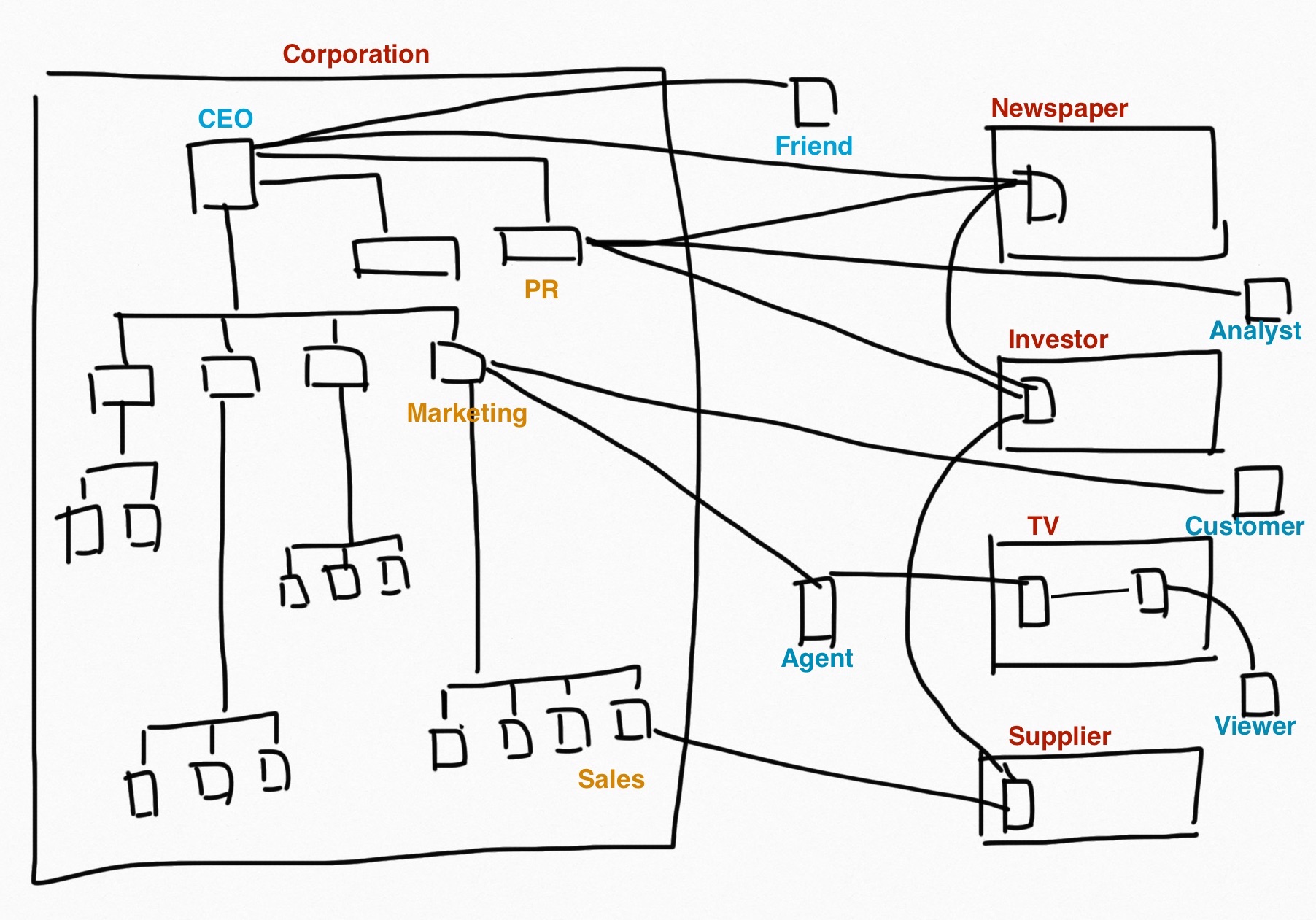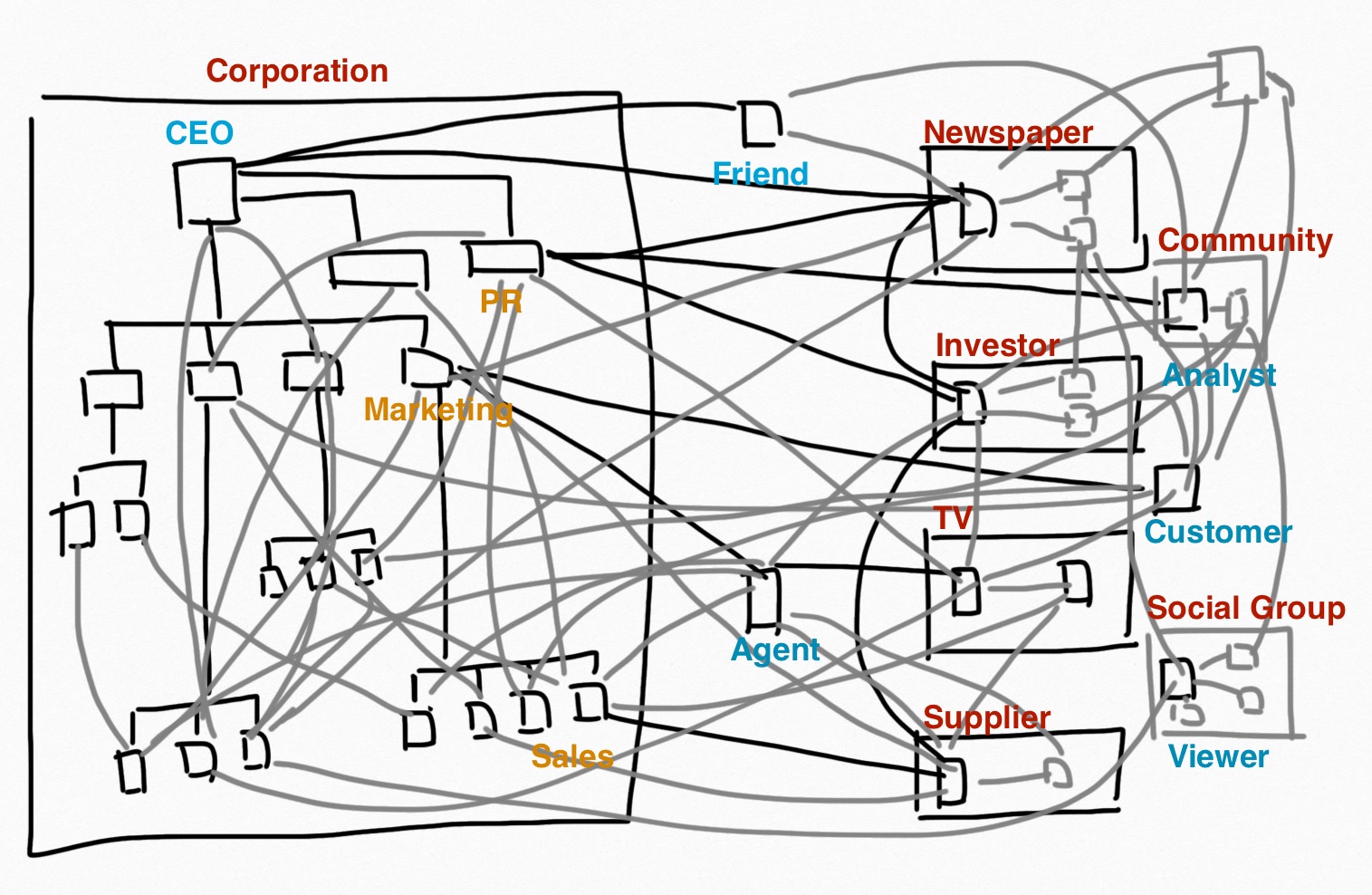Intranet 2.0 and Corporate Communication 1.0 can't work together. Corporate communication needs to develop a wide range of social and technical competencies.
IT departments were the first to acknowledge the potential of intranets and often used them for work and communication. Corporate communication then followed suit, showing that the intranet was something useful for companies as a whole. Corporate communication as an organizational unit took over the intranet and expanded it in its own way.
The following passage from Wikipedia explains:
Corporate communication is a set of activities involved in managing and orchestrating all internal and external communications aimed at creating favorable point of view among stakeholders on which the company depends. It is the messages issued by a corporate organization, body, or institute to its audiences, such as employees, media, channel partners and the general public. Organizations aim to communicate the same message to all its stakeholders, to transmit coherence, credibility and ethic. Corporate Communications help organizations explain their mission, combine its many visions and values into a cohesive message to stakeholders. The concept of corporate communication could be seen as an integrative communication structure linking stakeholders to the organization.
Corporate communication is all about sharing company information with employees. As soon as other organizational units began using intranets to communicate, they realized that they also wanted to have a say in how their intranets should be built. Management (usually the largest part of the budget) were the only ones who held corporate communication.
Intranets are traditionally closed areas to which only internal employees have access. Particularly in companies with several locations, a large part of the internal communication (discussed “within the company") takes place over the intranet.
As defined by Wikipedia, internal communication (IC) is:
the function responsible for effective communications among participants within an organization. The scope of the function varies by organization and practitioner, from producing and delivering messages and campaigns on behalf of management, to facilitating two-way dialogue and developing the communication skills of the organization's participants.Formal channels typically fall into one of four broad categories:
- Electronic: Communications that are delivered and/or accessed electronically, either by computer, telephone, television or other devices.
- Print: Paper-based communications.
- Face-to-face: One-to-one and one-to-many forums where people are physically present.
- Workspace: The working environment.
Informal channels reflect the non-linear dynamics of a social network and can be as influential, if not more so, than official channels, often more likely to stimulate and create discussion and dialogue. The channels may manifest themselves via the rumor-mill, water-cooler conversations, social networking, graffiti, spoof newsletters, etc.
Intranet 1.0
Corporate communication has always required formal internal communication. The shape that formal internal communication takes (how, when, and where it's used) often requires the use of corporate communication. From a traditional point of view, this has to do with the identity of the company, especially the imprint or even preservation of its corporate culture.
As long as intranets met expectations technologically, operationally and in infrastructure, they would continue to be used. Instructions and other content on paper were becoming less practical for corporate communications. Not to mention, paper documents (when they weren't distributed throughout the company) had generally very little reach.
Informal internal communication was, with a few exceptions, also quite limited in scope. Coworkers talked mainly in the break room or cafeteria. Corporate communication had little influence there, and the content that was otherwise "public" went mostly unnoticed, as long as it wasn't gossiped about or didn't "go around the office" as a rumor.
Corporate communication mostly kept internal communication in check in the days of "Intranet 1.0" because it had control over the intranet. When dealing with the outside world, corporate communication also had a higher level of control due to fixed interfaces in the form of people, responsibilities and fewer communication means (telephone, email, fax, etc.).

Corporate communication and intranet: Communication 1.0
In fact, this was already an assumed control. Opposition or “pressure” was then only sanctioned by corporate communications if it crossed a certain noticeable line. Organizational culture (along with content and type of communication or collaboration) cannot be kept in line in the sense that one tries to control only a small, individual part of it. An example of such control is outlined in the first level of Edgar H. Schein's cultural model. What is not seen or easily measured often gets ignored.
Intranet 2.0
Nowadays we talk of "Intranet 2.0", "Social Intranet", "Enterprise Social Networks", "Digital Workplace" and "Digital Transformation". Many companies have reacted to the ever-changing workplace with modern intranets, or they're in the middle of an intranet relaunch.
Projects and day-to-day business often take place in virtual project rooms in order to react quickly to changes. Work is carried out across departmental boundaries, and employees from other companies also work on internal projects. This means that coworkers are distributed throughout space and time. Teams and employees now have to act independently. Additionally, outside groups such as customers, are less interested in internal roles and more focused on results.
No longer are official company spokespersons the only ones out in public, but potentially every employee and partner of the company. Everyone communicates with everyone. Informal internal communication and (even) gossip take place on the intranet, too.

Corporate communication and intranet: Communication 2.0
The old-fashioned intranet won't work these days, simply because it does not regulate the tasks of employees. Intranet 2.0 is not just a mode of communication, it's a means of production, one in which products are manufactured and services are provided.
What This Means for Corporate Communication
This pushes corporate communication and its leaders into a kind of identity crisis. On the other hand, modern intranets offer more ways to achieve the goals of corporate communication - for example, through a dialogue with the employees. This is how internal communication within the company has become
part of an organization's identity with the aim of creating a 'we' consciousness to help promote and strengthen it.
(The Goal of Corporate Communication)
The goals of modern intranets coincide with the goals of corporate communication.
- Effective distribution of information
- Support of operational work
- Virtual emotional home base
(The Three Most Important Goals of Intranet 2.0 and How They Can be Measured)
However, the aim of corporate communications and communicators was (and still is, according to many) to achieve these objectives through control and guidance. In a modern intranet, however, not everything can be supervised, and not every communication and task can be given with exact instructions, which can ultimately limit the productivity of employees.
Increased networking with the outside world is also an important factor. More and more companies are "out" on the Internet and active in social media.
The introduction of social media into companies - whether a corporation or a small business - usually stems from one theme: the new mediums should be used to communicate with the young target groups, as they are increasingly inaccessible through the existing communication tools.
A decision maker hardly thinks of the consequences for his own company culture.
(Social Media – The Trojan in Traditional Corporate Culture's Fortress)
Corporate communication that gives off the outward image of "corporate culture 2.0," yet still insists on "company culture 1.0" internally, will inevitably run into contradictions and resistance – and eventually fall apart.
In this new environment, corporate communication can no longer be based on "command and control" behavior. Roles need to move away from order-giver and inspector and and make a shift towards teacher, consultant, and moderator.
Tanja Kampa, manager of Alstom's internal communication, vividly describes the new stress points of internal communicators:
Today, internal communicators spend their time somewhere between giving management advice and being spokespersons, motivational speakers for their coworkers, and listening ears. We are IT experts, translators, data protection specialists and legal advisors. Employees praise World Cup soccer bets and at the same time they complain that management invests time and money in such things, all while the need for job cuts circulates in the press.
(Changing Internal Communication – A Tightrope Walk Between Soccer Bets and Job Cuts)
Internal communication, then,
has to be a beacon during this cultural transformation – leading by example and enabling others within the organization to communicate freely and effectively with one another.
(The New Internal Communication – Much More than Emails and Intranet)
Corporate communication needs to build up a wide range of social and technical competencies, re-evaluate the new roles of discursive and advisory corporate communications, and master roles and skills such as:
- Intermediaries and qualifications for executives and employees across disciplines
- Moderation and advising
- Dialogue and networked action on the same level in digital and physical space
- Error tolerance in communication
- Mastering new technologies
- Leadership in digital technologies ( "early adopters").
- Management, coordination and development of communities in digital and physical space.
In the end, corporate communicators will have to accept a change in role similar to that of senior executives (The Changed Role of Executives).
With a new understanding of roles and abilities, corporate communication can continue to play a significant part within their organizations.
 Original article “Die Unternehmenskommunikation und das Intranet 2.0" published in German by Frank Hamm.
Original article “Die Unternehmenskommunikation und das Intranet 2.0" published in German by Frank Hamm.
Frank Hamm is a consultant for communication and collaboration who supports companies in their digital transformation. He has written for INJELEA-Blog about social business, intranets, enterprise 2.0 and company communication practices since 2005. Frank is an avowed nexialist and writes about this at Der Schreibende.
You can find more articles by Frank Hamm in our intranet special.


